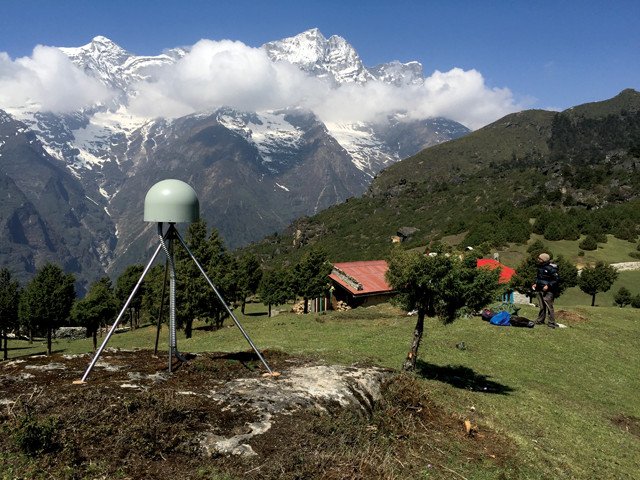
by Mary Caperton Morton Tuesday, September 13, 2016

Within days of the April 2015 Gorkha earthquake, UNAVCO researchers were on the ground in Nepal to collect geophysical data, check on instruments and help with relief efforts. Credit: UNAVCO/John Galetzka.
On April 25, 2015, a magnitude-7.8 earthquake struck Nepal, northwest of Kathmandu, damaging much of the capital city, flattening surrounding villages and killing more than 8,000 people. The quake’s hypocenter was relatively shallow, only 15 kilometers below ground on a fault that’s part of the Main Himalayan Thrust. Yet the displacement didn’t rupture all the way to the surface, indicating that only part of the fault slipped. Now, in a new study looking at how the fault continued to move following the 2015 event, researchers have found that the shallower section of the fault is likely still locked — and potentially loaded for another earthquake.
Nepal is prone to large earthquakes because it sits atop the collision zone between India and Eurasia. As India pushes underneath Eurasia, tectonic forces continue to raise the highest mountain range on Earth — the Himalaya — and produce large quakes. With the long history of strong earthquakes in the region — including deadly events in 1803, 1833, 1905 and 1947 — scientists have been monitoring Nepal’s main frontal thrust fault for decades. And data from a number of seismic and GPS instruments installed before and after the 2015 event are shedding light on the pattern of strain buildup and release in the Himalaya.
Previous work had shown that the 2015 event, nicknamed the Gorkha earthquake, only ruptured a portion of the locked fault. Sometimes, stress on portions of a fault that don’t slip during a big earthquake is later released slowly as afterslip. But the pattern of afterslip — or lack thereof — suggests that part of the thrust fault in Nepal is still locked, says David Mencin, a graduate student at the University of Colorado Boulder and a project manager at UNAVCO, who was the lead author of the new study published in Nature Geoscience.
Using a combination of GPS and interferometric synthetic aperture radar to study slow-motion changes in Earth’s surface after the quake, Mencin’s team detected 70 millimeters of afterslip north of the 2015 rupture and just 25 millimeters of afterslip south of the rupture over the shallower portion of the fault. “You would expect a large afterslip signal after such an event, but it doesn’t exist. All we’re seeing is a couple of centimeters [on the shallower portion], which doesn’t account for the three meters of offset [deeper] on the fault that the earthquake generated,” Mencin says. “This has implications for future great earthquakes, which can tap into this stored strain.”
More afterslip to the north fits geoscientists’ understanding of the geometry of the main frontal thrust fault, which dips more deeply to the north and is therefore warmer and more likely to creep slowly. “To the south is where the real questions lie,” Mencin says. The current results suggest “that the Gorkha quake loaded the fault to the south and all that energy is just sitting there, waiting to be tapped into by a future earthquake.” Mencin’s team estimates that about 3.5 meters of strain remain in the fault.
This pattern seems to echo the buildup and release of historic earthquakes in the region, says Jean-Philippe Avouac, a geophysicist at Caltech who was not involved in the new study. Many of the previous earthquakes recorded in historical texts or revealed by paleoseismic studies also failed to rupture to the surface, and few of those were followed by large subsequent events. This might be comforting if not for the possibility that it indicates that the whole region has potentially built up a reservoir of strain that could be released in a major event in the future.
“Now, our focus of worry is western Nepal, where no earthquakes have occurred since 1505,” Avouac says. “There is something like 10 meters of slip [estimated in earlier studies] that need to be released, which could result in a quake of magnitude 8.5 or higher.” Other regions of the Himalayan Thrust in Nepal, China and India have little to no history of major quakes, leaving an even bigger question about how much strain they could be harboring, he says.
Some buildings in Kathmandu have been retrofitted, or built new, to withstand earthquakes, and these fared relatively well in the Gorkha quake. But much of the rest of Nepal is vulnerable to damaging earthquakes due to its ancient infrastructure, built long before earthquake-resistant engineering was developed, Mencin says. In Nepal, “we have relatively small earthquakes causing a lot of damage and fatalities due to the lack of preparedness. The more we can learn about how the pattern of earthquakes in this region fits into the large earthquake cycle of the Himalaya, the better we can prepare for future events.”
© 2008-2021. All rights reserved. Any copying, redistribution or retransmission of any of the contents of this service without the expressed written permission of the American Geosciences Institute is expressly prohibited. Click here for all copyright requests.